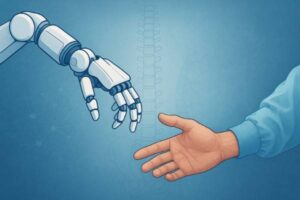Diagnosing a patient whose symptoms are as indiscernible as the expressions on their face when masked, throws another kind of a challenge for a doctor
Do you ever wonder what someone looks like behind their mask, someone you’re speaking to but have never met?
As a doctor, I indulge in this amusing activity daily. When we talk to new patients, the brain subconsciously analyses what the rest of their face must look like. Inevitably, at some point in the consultation, every single patient brings down their mask – either because their nose itches, their glasses are fogging, or from an inherent human desire to establish a personal connection – only to confirm to me that reality matches imagination in no way; those you perceive to be clean shaven have a scruffy beard, and those you think might have a sharp jawline have it covered by chubby cheeks instead.
A patient once asked me matter-of-factly, “Doctor, please could you lower your mask? I would like to see the full face of someone who is going to stick a knife into me!” I obliged gingerly, understanding fully well that an honest human connection demands transparency beyond the opacity of a veil that is dividing the entire human race in these times. Often, I am unable to recognize people who acknowledge me, and in a kind gesture, lower their mask to reveal their physiognomy. I am sometimes even more embarrassed when I fail to make the recognition despite this courtesy shown to me.
I was recently examining a hypertensive patient who had come to me after enduring a severe headache over the past few days. In the middle of the assessment, his fluorescent orange mask started to flutter. Given the variations in masks these days, for the first two seconds, I wondered if this was something new in the market – until I realized he was having a seizure. I pulled his visor down and saw his face twitching uncontrollably. Within seconds, his arms and legs started jerking, his mouth was frothing, and his eyes had rolled up. I lay him on the examining bed and put him on his side for the next few minutes until the fit abated, while his relatives stood there aghast at what they were seeing.
I dug my fist into into his sternum, deliberately causing him pain, and realized that he didn’t react by moving his left arm or leg. He was paralysed on that side while the right moved briskly. We immediately transferred him on to a hospital trolley and connected him to some oxygen while a nurse promptly pricked him to get intravenous access and pumped in some drugs, just like we see on every medical drama series on television. Except, over here, as the cliché goes, there are no retakes. Also, in television, the elevator is always ready, but in reality, the sicker the patient, the longer the elevator takes to get to you. Luckily, where I work, we have a system set in place for emergencies.
We rushed him down to the CT scan room and rolled him into the machine, watching it dissect an image of the patient’s head into 256 slices on the computer console. The scan revealed a large bleed in the right half of his brain, which explained why he wasn’t moving his left side. By the time we spiralled him out of the gantry, he was stuporous. We needed to shove a breathing tube down his throat to guard his airway and connected him to a ventilator to keep him breathing. His blood pressure was 220/110 mm Hg.
I explained to the family that he had had a stroke. “80% of strokes happen because of blockage of a blood vessel, which disturbs the brain because of a lack of blood supply to it. In these cases, we can give a clot-busting drug. He falls into the remaining 20%, where a stroke occurs owing to haemorrhage inside the brain,” I elucidated, while the team was already shaving his head, prepping him for surgery, which the family had instantly agreed to. Given its typical location, I told them with authority that the bleed was because of high blood pressure in his case, although sometimes, a large blood clot can ‘mask’ an underlying tumour, arteriovenous malformation, or aneurysm. We did a few more investigations to clear all of the above and swiftly transferred him to the operating room where a team was already spruced up and geared for his arrival.
Within minutes, we made a linear cut over his scalp and secured the bleeding from his thick skin with some plastic clips. We drilled a small hole and swirled around it to make it larger. I nicked into the dura and met the blood clot where it reached the surface of the brain. Blood clots in the brain are like people in a Matt Kahn quote: “They can meet you only as deeply as they have met themselves.” Using an endoscope to visualize it and a sucker to slurp it out, I navigated around to get all of it out until the tense brain regained its supple composure. Within a few days, he was alert enough to have his breathing tube removed, and his paralysis showed signs of reversal. “Quick removal of a clot like this prevents an entire cascade of secondary injury to the brain,” I explained to the family, who was relieved to see him finally being shifted out of the ICU and complaining about the horrible food in the hospital. He had every right to do so; after all, he was a Parsi being served vegetarian food.
On the 29th of October, we celebrated World Stroke Day. It’s frightening to know that 1 in every 4 adults above the age of 25 will suffer a stroke at some point in their life. It’s heart-breaking to learn that a stroke occurs every 5 seconds across the world, and gut-wrenching to fathom that out of every 10 strokes that happen worldwide, 1 of them happens in India. Mumbai itself sees about 50 strokes a day. Time is of essence in the diagnosis and treatment of strokes, and, very often, minutes can save lives.
Three months later, my patient came back to the clinic having completely regained function and resuming work. This time, his mask was fluorescent green with a big smiley on it. He removed it for me in a flourish so that I could check the symmetry of his face, the intonation of his voice, and the fluency of his speech, all of which had taken a beating from the stroke but were back in perfect harmony. I asked him to put his mask back on, lest he catch COVID from somewhere, which, I told him, also has an increased propensity to cause a stroke.
“Don’t worry, doctor! I have already taken the booster,” he winked. Now that’s a face I’ll always remember.





